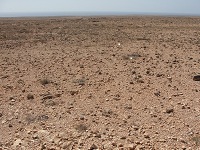Preliminary version 1 September 2013
Ramalina maciformis (Delise) Bory
Dict. Class. Hist. Nat. 14: 458 (1828)
Basionym: Parmelia maciformis Delise, Flor. Ègypte: 144 (1813).
Synonym: Index Fungorum
Type: Egypt, Moquattam, entre les fentes des rochers derrière la citadelle du Kaire. Whereabouts of original material not known.
Barcode: Data lacking.
Coordinates: WGS84, 30°3'22"N, 31°14'22"E, 30.056111°, 31.239444°, UTM 36R 330281 3326309
Thallus: fruticose, rigid, with laciniae from a broad holdfast. Laciniae up to 6 cm long, palmate, cuneate, or sublinear, sparingly divided, 0.5 - 6 cm broad, yellow-grey to pale yellow-green, smooth or scabrose, more or less reticulately rigded or cracked, with delimited, ulcerate areas on both sides producing coarsely granular soredia or corticale granules. Cortex 50 - 75 µm thick, chondroid cylinder absent, medulla dense, with imbedded strands of chondroid tissue (Krog & Osthagen 1980: 281). Apothecia up to 2 mm, disc pale green, surrounded by a corticate exciple . In some cases the margins proliferate in a way similar to those sometimes present in Ramalina fraxinea. The cortex of the exciple around the ascocarp is partially cracked or irregula. The ascocarps are plate-like or urceolate. Thecium about 70 µm high and is covered by a athick yellowish epithecium 10-12 µm high, which is slightly pruinose. The lentiform, colourless hypothecium is 100 µm thick at the centre (60 µm thick at the margin) and merges into a yellowish cortex. Below the hypothecium a conspcuous, interrupted layer of phycobiont cells is visible. the paraphyses are simple or with one or a few small proliferations at their apices. Normally the asci contain 8 colourless spores which are 2- oder somtetimes 4-septate. The spores are ellipsoid or slightly curved, 10 - 12 x 3 - 4 µm. Apothecia are only known from the western Negev, Israel (Kappen & Schulze 1972: 323) were they occur frequently. Pycnidia unknown (Krog & Østhagen 1980: 281).
Chemistry:
Race I: Norstictic acid, bourgeanic acid acid (Krog & Osthagen 1980: 281 from the Canary Islands). Usnic acid.
Race II: Salacinic acid, bourgeanic acid (Krog & Osthagen 1980: 281 from the Canary Islands). Usnic acid.
Ecology: Saxicolous.
Molecular data: Genbank
Distribution: North Africa, "rare in the Canary Islands" (Krog & Osthagen 1980: 281). Abundant in the plain west of Tindaya, Fuerteventura (Feuerer, pers. obs.) Database
Note:





